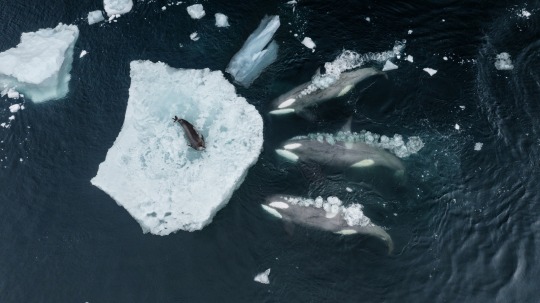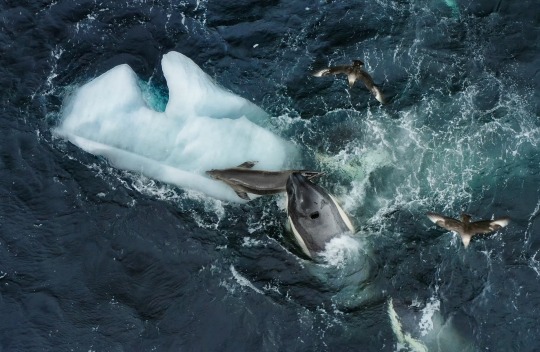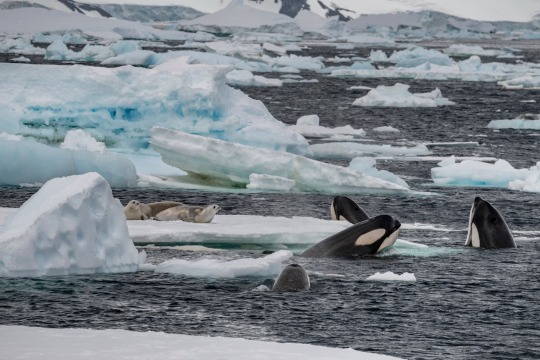#Master Hunting | On Ice 🧊
Text

These Orcas Have Mastered Wave Washing. It's spine-tingling to watch. Speeding toward a Seal, Orcas rotate to their sides in unison. The momentum will create a large wave that may be powerful enough to wash the Seal off the Ice Floe.
These Orcas Control The Waves To Hunt. It’s Spine-Tingling To Watch.
Using a Technique Passed Down Through Generations, these Orcas have Mastered Hunting—On Ice.
— By Natasha Daly | Photographs By Bertie Gregory | September 13, 2023
The first time the Weddell seal notices the orcas, it’s already surrounded. Until moments before, it had been resting on an ice floe deep in an Antarctic channel. Then three killer whales’ heads appear, bobbing up and down. The orcas are hunting.
On this sheet of sea ice, the nearly thousand-pound seal would be unreachable for most marine predators. But these orcas—a matriarch with her daughter and granddaughter—are three of about a hundred known to have mastered a hunting technique called wave washing. The secret: working together to turn water into a weapon.

An orca bites a crabeater seal. Unlike large, docile Weddell seals, crabeaters are aggressive and can be difficult to wave wash. As melting ice keeps more seals on land, these killer whales must hunt what they can find.
The orcas, having identified their target, form a battle line and start charging toward the floe. Just before reaching it, they rotate to their sides in a single, synchronized motion and plunge underwater. The momentum creates a wave so powerful that it floods the ice sheet, cracking the surface and whipping the flailing seal around. Slowly and methodically, they repeat the charge. The ice fractures more. On the third charge, the wave sends the seal flying into the sea. It scrambles to climb onto a piece of ice, then disappears from view, grabbed from below by a killer whale.

Killer whales spy-hop around a group of crabeater seals lying on an ice floe. The surfacing technique of spy-hopping allows an orca to survey its surroundings by holding its head out of the water, sometimes for several minutes, using its pectoral fins to stay afloat. Photograph By LeighHickmott

A Weddell seal reclines as a killer whale spy-hops behind it. Later, a pod of orcas successfully wave washed it into the sea. Photograph By Tom Walker

Multiple family groups of wave-washing killer whales get together to socialize. This gathering of about 20 orcas represents one-fifth of the entire known B1 global population in the western Antarctic Peninsula.
“It’s completely sinister to watch,” says wildlife filmmaker Bertie Gregory, who’s spent a decade tracking the orcas, known as B1, a population of pack ice killer whales. The level of intelligence that goes into making each wave “is staggering,” he says. “This isn’t subtle. They are problem solving using very complex teamwork. They’re using water as a tool.” Sometimes it’ll take one wave, about five minutes, before a seal is flung into the sea. Other times a pod can wave wash up to 30 times, about two to three hours, before getting the prey. Scientists rarely see failed hunts. “This behavior is not innate; it’s learned and mastered over decades,” says Gregory. “Every time they make waves, it almost feels like more of a teaching experience than hunting.”

A pod of B1 orcas floats in front of a glacier, in a behavior known as logging. Orcas, like all cetaceans, must consciously open their blowholes to breathe. While logging, cetaceans are able to sleep by shutting down half their brain at a time while the other half stays alert.

A crabeater seal and an Adélie penguin rest on an ice floe while a male killer whale spy-hops near them. The orca attempted to hunt the seal, but after several wave washes and an in-water chase, the seal escaped. Photograph By LeighHickmott

A mixture of sea and glacial ice floats in an Antarctic channel as an orca searches for seals to hunt. In previous years this area would have had much more ice cover. Last February, Antarctic sea ice hit a record low.
But as Antarctica warms and sea ice vanishes, Weddell seals are increasingly staying on land, out of orcas’ reach. To track how the B1 orcas cope with a warming habitat, scientists have identified all hundred or so individuals. They’ve found B1s are losing about 5 percent of their population every year. Whether this subgroup “will go extinct or just adapt their behavior, we don’t know,” says Gregory. But with fewer opportunities for the orcas to wave wash, “we’re seeing an extinction of a culture.”
#Orcas | Control | Waves | Hunt#Watching | Spine-Tingling#Technique | Passed Down | Generations#Master Hunting | On Ice 🧊#Photographs | Bertie Gregory#Natasha Daly#National Geographic
2 notes
·
View notes